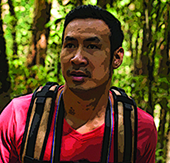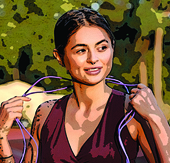

 |
 |
 |
 |
 |
  |
DAY 4 - MEDIKE’S LEOPARDS LEAVE THEIR WELCOME SCARS ON TREES
The group left Medike’s Marula campsite just after the break of dawn. The trail headed straight up the mountain, where a single-track trail wound its way up. The eleven adventurers had become used to the steep climbs, but the rocky sections still sapped their energy.
Once they reached the top, there was a small plateau, which provided a stunning view of the gorge below. From there they could marvel at the road they had just traversed and how high they had climbed in such a short space of time.
They didn’t have much opportunity for rest as the group now had to make their way through the mountainous bushveld, down into the Duluni Gorge. Once at the bottom, they encountered the stream, with its fresh and sparkling water – a welcome and refreshing break after the arduous descent. The trees that provided the shade included the odd yellowwood giant, as well as the more common Forest Fever Trees.
The route followed the stream, crossing it quite a few times. On a specific narrow section of the route Marelize spotted scratch marks on a tree stump. She had seen similar ones a few days before, in the gorge near Schoemansdal.
“Leopard marks,” confirmed Edwin, their very knowledgeable guide. “I will tell you a bit more about them when we stop for lunch at the cave.”
A bit of boulder hopping was required to get to Duluni Cave, but the prospect of having lunch and a bit of a rest stopped anyone from complaining.
“How can we be sure a leopard won’t be waiting for us here in the bushes?” asked Marelize, definitely sounding a bit nervous while offloading her backpack next to a rock.
“Highly unlikely. Any leopard would have heard us a long time ago and disappeared in the dense bushes. The chances of us seeing them are extremely slim,” Edwin reassured the group.
Their mentioning leopards sparked Taki’s interest. “How many leopards are there in this area?” she asked.
“Well, at the Medike Nature Reserve, at least four. They have even named them. Zack was first captured on camera in 2020. This was when the camera trap grid was initially set up to monitor the local wildlife. He was seen quite often during 2020, but then he started to come around less frequently. It is possible that a new leopard, named Thor, has moved in. He still dominates the territory,” said Edwin.
“And what about the ladies?” asked Taki.
“A female leopard called Samantha was caught on camera on several occasions. In 2020, she was sighted with a cub, which was named Lunar. Unfortunately, Lunar was only spotted a few times in 2020 and then he disappeared. Near the end of 2021, Samantha was spotted with another young cub. I haven’t seen the latest reports, but I must assume that the four leopards are still be roaming the area,” said Edwin.
Taki’s curiosity was now at fever pitch. “But how many of these lovely animals are still left in the Soutpansberg mountains?” she wanted to know.
“The research done the past few years has been very helpful,” said Edwin. “A decade ago, scientists were very worried that no more leopards would be left in the Soutpansberg by 2020. The 2021 data suggests that there are still roughly eight leopards per 100 square kilometres in the mountain. In the Western Soutpansberg, 30 different leopards could be identified last year, 17 of them being females. It shows a reasonably healthy and stable leopard population, but these animals are still endangered,” Edwin continued.
“Well, that’s enough about the cats and the scars they leave on trees,” Marelize interrupted with a shiver. “We still have to eat, and then we have to get moving to reach Leshiba’s Luvhondo Camp before dark, but first we have to hear from … Wait, whose turn is it…?”
“Emma. I think it’s Emma’s turn,” said Gerrit, plonking himself down and grabbing his water bottle. He glanced over at Emma, who looked a bit startled, but then she seemed to collect herself and looked a bit resigned that her turn to bare her soul had come.
Sources for this article:
https://www.ewt.org.za/old-salt-trail-description-slackpacker/
https://www.facebook.com/watch/?ref=external&v=682046753030172
https://primateandpredatorproject.files.wordpress.com/2022/01/western-soutpansberg-leopard-monitoring-report-2021_final.pdf
Click here to read Emma's story
To learn more about Medike, visit the Endangered Wildlife Trust (EWT)’s website:
https://www.ewt.org.za/ewt-destinations/ewt-destinations-medike-3/
DAY 4 –Entering Leshiba - One of the gems of the Soutpansberg
Lunch at Duluni cave was a welcome break for everyone. The discussion about leopards, however, caused mixed reactions. Every thick bush was viewed with some suspicion, and the trees were scrutinised to check whether a leopard’s tail might be hanging from it, just waiting to leap down on some hapless victim...
The group followed the stream up the gorge through more forested area. The route took them past some old stonewall terraces. Edwin explained the significance of the rock faces and hinted at the many stories the terraces would be able to tell.
“Do you want to see more of the rock paintings?” Edwin asked. He didn’t even have to wait for an answer as the group members all started walking in the direction he was indicating. The diversion did not, however, take not long as they knew that the camp at Leshiba Mountain Retreats was still a few kilometres away.
Once back on the trial, they made their way upstream until they reached the Leshiba fence. Here they had to take off their backpacks and crawl through the “Hiker’s Doggy Door”, a cunning swing gate that ensured that the gate closed behind the hikers.
“And now we’re officially on one of the Soutpansberg’s best-known tourism treasures,” Marelize remarked, looking really chuffed. “This is one of the places I’ve always wanted to see. I’ve only read about the 2 500 hectares of unspoilt nature. A place where giraffe, red duikers and mountain reedbuck still roam freely.”
“Someone told me that the rare Narina Trogon also visits Leshiba. Will we see some?” Zachary interrupted somewhat excitedly. Edwin found the fact that Zachary was a “birder” who knew what species occurred there somewhat surprising. “We may, depending on your luck,” he responded while giving a shrug.
The next couple of kilometres were every hiker’s dream. The gradient was very gentle, and in the distance they saw a warthog and even an inquisitive klipspringer. The route took them through mountain bushveld, silver cluster-leaf woodlands, and an open vleiland, where they spotted a pair of purple-crested loeries.
Once past the wetland section, a rocky path led them along the river, up to a little dam in a mountain stream. “Anyone for an afternoon swim?” asked Edwin. “I’m tempted, but there is no way I’m going to dig into my backpack, get out my polka-dot bikini and jump into the cold water. I’ll rather hold out for the showers at the camp,” said Marelize. The laughter that broke out could either be because the rest of the group agreed or because they found the thought of Marelize in a polka-dot bikini in the middle of the bushveld extremely funny.
 The final stretch of the trail took the group across the Leshiba plains to the front of the lodge. Edwin arranged for a stopover at reception, where they could marvel at the sculpted woodwork of famous local artists. The reception area and restaurant resembled an authentic Venda village, re-created by internationally renowned artist Noria Mabasa.
The final stretch of the trail took the group across the Leshiba plains to the front of the lodge. Edwin arranged for a stopover at reception, where they could marvel at the sculpted woodwork of famous local artists. The reception area and restaurant resembled an authentic Venda village, re-created by internationally renowned artist Noria Mabasa.
After a quick drink, the hikers made their way along the farm track to Leshiba’s Luvhondo Camp, where the fantastic Leshiba staff were already waiting for them. The group members were swiftly guided to their luxurious huts, complete with hot showers.
Three hours later, the group settled around the campfire. Dinner was unbelievable, only surpassed by the serenity of the environment. The atmosphere was perfect for another story. Tonight, Shabnim had volunteered to tell the tale of her scar.
Click here to read Shabnim's story
Information sourced from:
https://www.ewt.org.za/old-salt-trail-description-slackpacker/
Meet the adventurers:
 |
Our narratorMarelize (27) is the narrator of the story. She is a seasoned traveller and has visited countries in Europe and the USA. |
|
Rovha is a soft-spoken dentist with smiling eyes. He is a loner and can often be found in a quiet corner reading a book or newspaper. |
 |
 |
Gerard is a Dutch adventure tourist. At 66 he has retired from the university he has been teaching at. He now spends his time travelling. |
|
Zachary (39) is a geologist. His insatiable thirst for adventure has taken him on many dangerous trails and earned him the title of Bear Grylls. |
 |
 |
Lee (28) has never let her neurological disorder become a disablity. Although physically strong, she has a emotional scar she hides well. |
|
Emma is a 37-year-old award-winning journalist who is currently working for a local newspaper but aspires to be a war photographer. |
 |
 |
Shabnim's small stature may be deceiving but at age 42, she is a tough adventurer and a well-respected lecturer at a local university. |
|
Adrian is a boisterous character who enjoys controlling the conversation. He usually leads the pack and shares his expertise freely. |
|
 |
With a military background, Gerrit (55) was a captain in the old South African Army. He has seen the horrors of war and still runs from it. |
|
For the vibrant and energetic 25-year-old Takalani (Taki) nursing has always been |
 |
 |
Lisa (53) is the mother of two grown daughters and the wife of a wealthy CEO who travels a lot. Lisa has taken up hiking to fill her days. |






